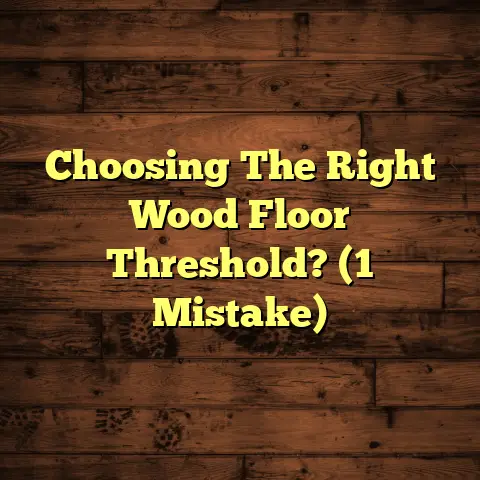Silence Squeaky Floors: How To Lubricate? (1 Fix!)
Let’s be honest, a quiet home is more than just a luxury; it’s an investment in your well-being.
Think about it: excessive noise, like the creak-creak-creak of a troubled floor, can be a real stress trigger.
Studies have shown a direct link between noise pollution and increased levels of stress, anxiety, and even sleep disturbances.
A study published in the “Journal of Environmental Psychology” found that chronic exposure to noise can elevate cortisol levels, the body’s primary stress hormone.
[^1]
[^1]: (Brereton, T., & Clinch, J.
P.
(2009).
Environmental noise and health in Europe.
Journal of Environmental Psychology, 29(2), 255-264.)
Imagine trying to relax after a long day, only to be greeted by a symphony of squeaks with every step.
Not exactly the recipe for a peaceful evening, right?
Squeaky floors are a super common household problem.
They can really mess with the vibe of your living space.
This isn’t just about annoyance; it’s about creating a sanctuary where you can truly unwind and recharge.
That’s where I come in.
In this article, I’m going to share a simple, effective lubrication method that I’ve used countless times to silence squeaky floors and bring tranquility back into homes.
Trust me, you’ll be amazed at the difference a little bit of TLC can make!
Section 1: Understanding Squeaky Floors: Why the Noise?
So, what’s the deal with squeaky floors anyway?
It’s not just random bad luck.
There are usually specific culprits behind the noise.
Here’s a breakdown of the most common causes:
Loose Floorboards: This is a big one.
Over time, nails or screws holding the floorboards down can loosen, creating space for movement.
When you walk across these loose boards, they rub against the subfloor or adjacent boards, resulting in that telltale squeak.Friction Between Wood and Nails: Even if the floorboards aren’t completely loose, the constant pressure and movement can cause the wood to rub against the nails or screws.
This friction generates that irritating squeaking sound.Changes in Humidity: Wood is a natural material, and it expands and contracts with changes in humidity.
In the winter, when the air is dry, wood shrinks, creating gaps between the boards.
In the summer, when the air is humid, wood expands, which can cause boards to rub against each other.Subfloor Issues: Sometimes, the problem isn’t with the flooring itself, but with the subfloor underneath.
If the subfloor is uneven or has loose areas, it can cause the flooring to squeak, even if the flooring is properly installed.
Now, which types of flooring are most prone to these noisy issues?
Generally, you’ll find squeaks more often in:
- Hardwood Floors: Solid hardwood is beautiful, but it’s also susceptible to changes in humidity, making it prone to squeaking.
- Laminate Floors: While laminate is more stable than hardwood, it can still squeak if it’s not properly installed or if the subfloor is uneven.
- Engineered Wood Floors: Engineered wood is more resistant to moisture than solid hardwood, but it can still squeak if the installation isn’t done right or if the subfloor has issues.
Think of a squeaky floor as an early warning sign.
It’s your floor telling you something’s not quite right.
Ignoring it won’t make it go away; in fact, it will likely get worse over time.
Addressing the problem early can prevent more extensive (and expensive) repairs down the road.
Section 2: The Importance of Addressing Squeaky Floors: More Than Just Annoyance
Okay, so squeaky floors are annoying.
We’ve established that.
But it’s more than just a minor inconvenience.
Living with constant squeaks can actually have a negative impact on your health and well-being.
Remember that study I mentioned earlier about noise pollution and stress?
Well, squeaky floors fall squarely into that category.
The constant, unpredictable noise can elevate your stress levels, making it harder to relax and unwind.
Over time, chronic stress can lead to a whole host of health problems, including:
- Increased anxiety: The constant noise can put you on edge, making you feel more anxious and irritable.
- Sleep disturbances: Squeaky floors can make it difficult to fall asleep or stay asleep, leading to fatigue and decreased productivity.
- Headaches: Noise pollution is a known trigger for headaches and migraines.
- High blood pressure: Chronic stress can contribute to high blood pressure, increasing your risk of heart disease and stroke.
Beyond the health implications, unresolved squeaks can also lead to further damage to your floors.
The constant movement and friction can weaken the floorboards and the subfloor, potentially compromising the structural integrity of your floor.
This can lead to more extensive repairs down the road, costing you time and money.
Let’s not forget the emotional and psychological benefits of a serene living space.
A quiet home is a sanctuary where you can relax, recharge, and focus on the things that matter most.
Imagine being able to:
- Concentrate better: Without the distraction of squeaky floors, you can focus more easily on work, hobbies, or spending time with loved ones.
- Relax more deeply: A quiet home creates a sense of calm and tranquility, allowing you to unwind and de-stress after a long day.
- Sleep more soundly: Eliminating noise pollution can improve your sleep quality, leaving you feeling refreshed and energized.
In short, addressing squeaky floors is an investment in your health, your home, and your overall quality of life.
Section 3: Preparing for the Lubrication Process: Getting Ready to Silence
Alright, you’re convinced. It’s time to tackle those squeaky floors!
Before you dive in, let’s make sure you have everything you need and that you’re prepared for the task at hand.
Here’s a list of materials you’ll need:
- Lubricant of your choice: I’ll go into more detail about the different options in a moment, but some popular choices include silicone spray, WD-40, and paraffin wax.
- A small container: This is useful if you’re using paraffin wax, as you’ll need to melt it down.
- A clean cloth or brush: This will help you spread the lubricant evenly and clean up any excess.
- A drill with a small drill bit (optional): This may be necessary if you need to create a small pilot hole to reach the source of the squeak.
- Safety glasses: Protect your eyes from any splashes or debris.
- Gloves: Protect your hands from the lubricant.
Now, let’s talk about lubricant options. Here are a few of my go-to choices:
- Silicone Spray: This is a great all-around lubricant that’s safe for most types of flooring.
It’s also relatively odorless and won’t stain. - WD-40: While WD-40 is technically a water displacement spray, it can also be effective at silencing squeaky floors.
However, it has a strong odor and can potentially damage some types of flooring, so test it in an inconspicuous area first. - Paraffin Wax: This is a more natural option that’s particularly effective for filling gaps between floorboards.
You’ll need to melt it down before applying it.
Once you’ve gathered your materials, it’s time to prepare the area for lubrication.
Here’s a step-by-step guide:
- Identify the squeaky spots: Walk around the room and listen carefully for the areas that are squeaking.
Mark these spots with tape or a pencil. - Clear the area: Move any furniture or rugs that are in the way.
You want to have clear access to the squeaky spots. - Clean the floor: Sweep or vacuum the floor to remove any dirt or debris.
This will help the lubricant penetrate more effectively.
Before you start squirting lubricant everywhere, let’s go over a few safety tips:
- Read the product instructions: Always read and follow the manufacturer’s instructions for the lubricant you’re using.
- Work in a well-ventilated area: Some lubricants can have strong odors, so make sure you’re working in a well-ventilated area.
- Wear safety glasses and gloves: Protect your eyes and hands from any splashes or debris.
- Test the lubricant in an inconspicuous area first: Before applying the lubricant to the entire floor, test it in a small, hidden area to make sure it doesn’t damage the finish.
- Be careful when using power tools: If you need to use a drill, be sure to follow all safety precautions.
With these tips in mind, you’re ready to move on to the main event: lubricating those squeaky floors!
Section 4: The One Fix: How to Properly Lubricate Squeaky Floors
Alright, let’s get down to business!
Here’s my tried-and-true method for lubricating squeaky floors and silencing those annoying noises:
Step 1: Identify the Squeaky Area and Assess the Floor Type
- Walk the walk: Stroll across the floor, pinpointing exactly where the squeaks originate.
Is it a specific board, a joint between boards, or a larger area? - Know your floor: Determine the type of flooring you’re dealing with (hardwood, laminate, engineered wood, etc.).
This will help you choose the right lubricant and application method.
Step 2: Apply the Chosen Lubricant Directly to the Squeaky Spot
- Silicone Spray or WD-40:
- Precision is key: Aim the nozzle of the spray can directly at the squeaky spot, focusing on the seams and joints between the boards.
- Short bursts: Apply the lubricant in short bursts, avoiding oversaturation.
You want to get the lubricant into the gap, not create a puddle on the surface. - Hard-to-reach spots: If the squeak is coming from under a baseboard or in a tight corner, use the extension tube that comes with most spray cans to reach the area.
- Paraffin Wax:
- Melt it down: In a double boiler or microwave (in short intervals), melt the paraffin wax until it’s completely liquid.
Be careful not to overheat it. - Careful application: Using a small brush or syringe, carefully apply the melted wax to the squeaky spot, focusing on the seams and joints between the boards.
- Work quickly: The wax will start to harden quickly, so you’ll need to work efficiently.
- Melt it down: In a double boiler or microwave (in short intervals), melt the paraffin wax until it’s completely liquid.
Step 3: Use a Cloth or Brush to Spread the Lubricant Evenly
- Gentle touch: After applying the lubricant, use a clean cloth or brush to gently spread it evenly over the area.
This will help it penetrate into the gaps and prevent any buildup on the surface. - Wipe away excess: Be sure to wipe away any excess lubricant to prevent it from attracting dirt and grime.
Step 4: Test the Area and Repeat if Necessary
- The moment of truth: Walk over the area again to check for any remaining squeaks.
- Second application: If you still hear squeaking, repeat steps 2 and 3.
You may need to apply a second or even third coat of lubricant to completely silence the squeak. - Patience is a virtue: Sometimes, it takes a little time for the lubricant to fully penetrate and work its magic.
Give it a few hours and then test the area again.
Step 5: Allow Time for the Lubricant to Settle and Dry
- Read the instructions: Check the product label for specific drying times.
- Avoid foot traffic: Try to avoid walking on the area until the lubricant is fully dry.
This will prevent it from being tracked around the house.
Helpful Tips and Alternative Methods
- Hard-to-Reach Areas:
- Pilot hole: If you can’t reach the source of the squeak with the lubricant, you may need to drill a small pilot hole through the flooring.
Use a drill bit that’s slightly smaller than the nozzle of the lubricant can. - Shims: If the floorboards are loose, you can try inserting small wooden shims between the boards and the subfloor to stabilize them.
- Pilot hole: If you can’t reach the source of the squeak with the lubricant, you may need to drill a small pilot hole through the flooring.
- Alternative Lubricants:
- Talcum Powder: For minor squeaks, try sprinkling talcum powder between the floorboards.
The powder will help reduce friction and silence the squeak. - Graphite Powder: Graphite powder is another option for lubricating squeaky floors.
It’s a dry lubricant that won’t attract dirt and grime.
- Talcum Powder: For minor squeaks, try sprinkling talcum powder between the floorboards.
- When to Call a Pro:
- Extensive damage: If the squeaking is widespread or if you notice other signs of damage, such as warped or cracked floorboards, it’s best to call a professional flooring contractor.
- Unsure of the cause: If you’re not sure what’s causing the squeaking, a professional can help you diagnose the problem and recommend the best solution.
Effectiveness and Maintenance
This lubrication method is highly effective for silencing squeaky floors, especially when the squeaks are caused by friction between wood and nails or loose floorboards.
However, it’s important to remember that this is not a permanent fix.
Over time, the lubricant may wear off, and the squeaks may return.
To prevent future squeaks, I recommend:
- Routine checks: Regularly check your floors for squeaky spots and lubricate them as needed.
- Humidity control: Maintain a consistent humidity level in your home to prevent wood expansion and contraction.
- Proper cleaning: Keep your floors clean to reduce friction and wear.
Section 5: Aftercare and Maintenance: Keeping the Silence
So, you’ve successfully silenced your squeaky floors. Congratulations! But the job isn’t quite done.
To keep your floors quiet and prevent future squeaks, it’s important to establish a routine of aftercare and maintenance.
Routine Checks:
- Listen up: Make it a habit to walk around your home periodically, paying attention to any new squeaks that may develop.
- Early detection: The sooner you identify a squeaky spot, the easier it will be to fix.
Periodic Lubrication:
- Reapply as needed: Depending on the type of lubricant you used and the amount of foot traffic your floors receive, you may need to reapply the lubricant every few months or once a year.
- Preventative maintenance: Even if you don’t hear any squeaks, it’s a good idea to lubricate the seams and joints between your floorboards periodically as a preventative measure.
Humidity Control:
- Maintain consistent levels: As I mentioned earlier, humidity plays a big role in the health of your floors.
Aim to maintain a consistent humidity level in your home, ideally between 30% and 50%. - Humidifiers and dehumidifiers: Use a humidifier in the winter to add moisture to the air and a dehumidifier in the summer to remove excess moisture.
- Monitor humidity levels: Use a hygrometer to monitor the humidity levels in your home.
Proper Cleaning:
- Regular sweeping and vacuuming: Sweep or vacuum your floors regularly to remove dirt, dust, and debris.
- Damp mopping: Damp mop your floors with a mild cleaning solution as needed.
Avoid using harsh chemicals or abrasive cleaners, as these can damage the finish. - Avoid excessive water: Never allow water to pool on your floors, as this can cause them to warp or swell.
- Use floor protectors: Place felt pads under the legs of furniture to prevent scratches and dents.
Additional Tips:
- Inspect your subfloor: If you’re experiencing persistent squeaks, it’s worth inspecting your subfloor to make sure it’s in good condition.
- Consider professional help: If you’re not comfortable inspecting your subfloor yourself, or if you suspect there may be structural issues, it’s best to call a professional flooring contractor.
By following these aftercare and maintenance tips, you can keep your floors quiet, healthy, and beautiful for years to come!
Conclusion: Embrace the Silence
So, there you have it!
A simple, effective method for silencing squeaky floors and bringing tranquility back into your home.
Let’s recap the key points:
- Squeaky floors are a common problem caused by friction, loose floorboards, and changes in humidity.
- Addressing squeaky floors is important for your health, your home, and your overall quality of life.
- Lubrication is a simple and effective fix that can silence squeaky floors and prevent further damage.
- Aftercare and maintenance are essential for keeping your floors quiet and healthy.
Remember, a quiet home is more than just a luxury; it’s an investment in your well-being.
By eliminating noise pollution, you can reduce stress, improve sleep, and create a more peaceful and relaxing environment for yourself and your family.
I’ve seen firsthand the transformation that can occur when a homeowner finally silences their squeaky floors.
It’s like a weight has been lifted, and they can finally relax and enjoy their home to the fullest.
Call to Action: Your Journey to a Quieter Home Starts Now!
Don’t let squeaky floors continue to disrupt your peace and quiet.
Take the first step toward a more serene living space by using the lubrication method I’ve outlined in this article.
You deserve to live in a home that’s free from annoying noises and filled with tranquility.
So, grab your lubricant, gather your tools, and get ready to silence those squeaky floors once and for all!
Your health and well-being will thank you for it.





